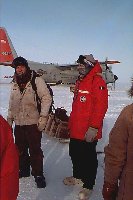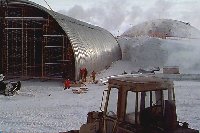
Re-pressurizing
It’s done. I’ve measured smoke next to the bar, smoke behind planes, smoke in
the tractor cabs and smoke in one of the new buildings near the runway. There’s smoke
everywhere, because there has to be heat and power and motion, and that is provided by
burning fuel. I was out late last night watching planes on the runway, taking notes of the
movements of tractors – but the second time, I dressed properly. All the data is in
my laptop and it looks really good. It’s certainly advantageous to be able to prepare
a professional-looking chart within half an hour of taking the disk of raw data out of the
instrument. I suppose Bill Gates got to be rich for a reason.
Yesterday, planes were delayed and at one point there were two of them idling on the Pole runway like angry cats, growling and swishing their tails, because bad weather had shut down McMurdo. Today dawned cloudy and ominous, but then the clouds thinned out and I had a nice display of blue sky for my farewell.
( I bet you read right past that without blinking. ‘Dawned’ ?? what do I mean ‘DAWNED’ ?? There’s only one dawn per year at Pole, and it lasts for several days. Nevertheless, people at Pole use the terminology "Last Night", "Tomorrow Morning" , "Afternoon" etc. in the conventional way, despite the fact that these concepts are completely artificial. )
Now we’re on our way back in the plane. Starting air pressure equivalent to 11,000 feet, the Pole ambient. As the flight proceeds, they will gradually re-pressurize the cabin to bring us back to sea level. No matter how much you stayed indoors at Pole, even if you stayed in a building in the Dome and only left it to go across to the galley, there’s no escaping the altitude. Back to McMurdo, back down to earth – yes, Earth, of which there is none at Pole – back towards the real world, one step at a time. The first step is to come down from the mountain, relinquish the rarefaction, the subtle reminder that one-third of the atmosphere is below you, the lack of breath that always tells you where you are.
I am not sure if there are heroics at McMurdo – remarkable achievements, great
challenges met. Somehow I cannot visualize it there, it doesn’t fit. Too many people.
Mactown has a night time defined by lack of activity, and thereby obvious by contrast. At
Pole, the exigencies of getting everything done in a very short time under extremely harsh
conditions dictate round-the-clock work. Tractors chug, construction crews hammer and
shout in three shifts. 
The sun goes round and round relentlessly, making no distinction for the clock. You sleep when your work is done, you wake when your alarm beeps. The view through the window is identical except for the direction of the shadows.
The Great Achievement at Pole this season was the construction of a new arch, the start of the lengthy process of completely rebuilding the station for the next century. One step at a time, old structures will be removed, new facilities built within the scope of the master plan.
One segment at a time, the arch sections are assembled on the ground and then hoisted into place.
The work has to be finished this season: they can’t possibly depart for the winter and leave it incomplete. Yet the start of work was delayed 12 days at the beginning of the season due to bad weather: that’s 12 percent of the 100-day season, one-eighth of the total. Jerry Marty is in charge: he worked construction as a young man and has worked his way up through the ranks to where he is now in NSF’s management. The roughnecks know this: in turn, he knows what’s possible, what’s not. Respect is tough to earn, easy to lose. The guys and women clambering on the arch at 40 below work for Jerry and The Goal: completion.
The last section is hoisted and bolted: Jerry is a happy man. He marks his calendar: on schedule, under budget, despite starting 12% late. When the finishing touches are done and the site is cleaned up for winter, the beer will flow – but not a moment sooner, nor a moment later than the last date for the last flights out. These people are the heroes.
![]() Back to Tony's Antarctica Interactive Trip
Back to Tony's Antarctica Interactive Trip
Prepared by Tony Hansen, Garry Rose and Paul Babushkin. Last edited 12 Feb. 1998